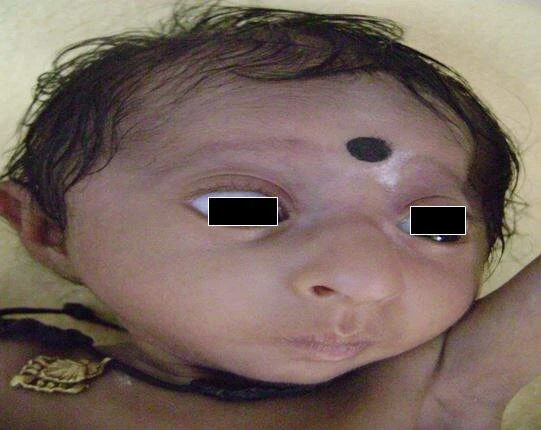Pediatric history taking and examination | Seckel syndrome
Table of Contents
Table of Contents
This guide covers Pediatric Short case history and examination for a Dysmorphic child with Seckel syndrome. Short cases have limited history but mainly highlight the findings of one system or one aspect. Conclusions must be drawn based on that.
Despite the short, history and examination time allotted to them, short cases are excellent in testing focused history and clinical examination skills. The post outlines a general approach to attempting a short case presentation in exams.
Demography
- Age 7 months
- Sex-Female
- Date of admission xx/xx/xxxx
Chief Complaints
Attended clinics for follow-up. The infant is not gaining age-appropriate weight and height and has abnormal facies and is advised for follow-ups.
Many short cases in exams might not have been admitted for acute complaints but for planned follow-ups.
History of present Illness (HOPI)
Antenatal history
- Uneventful progress of pregnancy
- Appropriate weight gain throughout the pregnancy
- Mother appropriately immunized for tetanus
Natal history
- Normal vaginal delivery at district Hospital xxx on xx/xx/xxxx
- Birth weight is 1.3 kg
- has Cried immediately after birth and required only routine care.
- No history suggestive of birth asphyxia
- Dysmorphic features were found at birth (details in physical examination)
Negative history
- No history of any medicine or drug intake during pregnancy
- No history of seizures, TB, DM, or hypertension in the mother
- No history of consanguinity
- No history of previous abortion/stillbirth
Family history
- No history of relevant illnesses in the father or immediate family members
Feeding history
EBM with top milk with Katori & spoon
Treatment history
- Admitted on 2ndday of life for IUGR
- Hospitalized for 14 days, treated for sepsis
- Is on regular follow-ups, and being given vitamin supplements.
Developmental history
- Social smile- 3 months
- Head control - 4 ½ months
- Rolling over- 5 months
- Bisyllable - 6 ½ months
Conclusion- Development seems more or less appropriate for the age. Will need more details and clinical notes from the previous follow-up.
Physical examination Findings
General Examination
- Clinically Term, dull but looking around
- Normothermic
- HR- 118/min
- RR 46/min
- CRT 3 secs
Anthropometry
- Weight is 2.950kg{3rdpercentile}
- Length 50 cm{ 3rdpercentile}
- OFC 31.5 cm { 3rdpercentile}
- CC 32.5cm
- US to LS ratio -
Conclusion- Severe malnutrition. Severely wasted and stunted according to IAP criteria with proportionate short stature
Head-to-toe inspection for dysmorphic features
- Beaked nose
- High arched palate
- Low set ears
- Receding forehead
- Protruding eyes
- B/L CTEV of feet
- Jaw appears hypoplastic
 |
| Seckle syndrome - facial features |
Systemic examination
Respiratory
- No dyspnea, no retractions
- b/l equal air entry
- normal Vesicular breath sounds
Cardiovascular
HS regular, S1S2normalno murmur. No clinically significant findings
Abdominal examination
- Soft, non-tender on palpation, liver is 2cm, span is --
- Spleen is impalpable, and hernial orifices are clear
CNS
- Lethargic but looking around
- OFC 28 cm
- Neonatal reflexed are sluggish
Investigation
Labs
- Ø HB 15.2gm
- Ø Blood counts normal
- Ø CRP positive
Imaging
X-ray chest PA view-shows normal findings
Babygram(Radiograph of the whole body of a new-born)
 |
| Seckle syndrome - hypoplastic mandible |
 |
| Seckle syndrome - Internal rotation of bilateral femur |
- No lytic or sclerotic lesion seen in the skull vault
- hypoplastic mandible
- internal rotation of both feet
- no lytic or sclerotic lesion involving long bone
USG ABD & KUB- no abnormality detected
C.T.Brain - findings are normal
Differential diagnosis
- Seckle syndrome
- Micro cephalic osteodysplastic Dwarfism[MCODD] type 2 & type 3
- Other causes of dwarfism
Points in favor and against formicro-cephalicOsteo-dysplastic dwarfism
| Features | Index Case | MCODD |
| Microcephaly | √ | √ |
| Coxa Vara | × | √ |
| V-Shaped distal femoral metaphysis | × | √ |
| Epiphysiolysis & metaphysial flaring | × | √ |
Seckel syndrome- Overview
Introduction
Seckel syndrome is an extremely rare genetic disorder. It is also most common cause of osteodysplastic dwarfism.
Genetic etiology
- The mode of inheritance isAutosomal recessive.
- Caused by a mutation inATR genemainly.
- SCKL 1 gene on human chromosome 3q i.e. ATRgene.
- SCKL 2 mapped on chromosomes 18p, 14q showing genetic heterogeneity.
- SCKL 3 study shows its association but needs further studies.
Typical characteristic features of Seckel syndrome (Phenotypical findings)
- Proportionate dwarfism which is prenatal in onset
- Severe microcephaly
- Bird headed appearance
- Mental retardation
Associated Clinical features
- IUGR
- Proportionate short stature
- Microcephaly
- Mean OFC is -9SD or range -4 to-14SD
- Bird headed profile
- Receding forehead
- Large eyes
- Beak-like protrusion of the nose
- Narrow face
- Receding lower jaw
- Micrognathia
- Mental retardation in 50%
Other associated features
- Premature closure of cranial sutures
- Large eyes
- Antimongloid slant of palpebral fissures
- High arched palate, cleft palate
- Dysplastic ears
- Cryptorchidism, clitoromegaly
- Hirsutism
- Crowded teeth with malocclusion, enamel hypoplasia
- Agenesis of corpus callosum
- 25% have aplastic anemia or malignancies
Diagnosis
Diagnosis depends on the recognition of clinical findings of dysmorphism along with X-ray features such as
- Retarded bone age
- Frequent dysplasia
- Dislocation of the head of the radius
Genetic counseling
The risk of recurrence is 25% for couples having their first child with seckle syndrome
Multiple occurrences in siblings with parental consanguinity support an autosomal recessive inheritance.
Counseling for other members is reassuring because of the low occurrence of disease unless the couple is consanguineous.
Antenatal diagnosis
If the first child is affected then rule out the occurrence of seckel syndrome can be ruled out by
USG which shows IUGR with microcephaly by 2ndtrimester
Early molecular antenatal diagnosis if the first child is affected with seckel syndrome and familial mutation has been identified.
Management
- Treatment is focused on the specific problems the affected child has.
- Appropriate social and psychological support for the patient and families to help with mental retardation.
- Medical management is to be provided forHematological abnormalitiessuch as Anemia, pancytopenia, andAML which are associated with seckel syndrome
- Follow up for nutrition, growth, and screening for medical issues which can be addressed such as anemia.
Author

Ajay Agade | DNB(Pediatrics), FNB(Pediatric Intensive Care), Fellowship in Pediatric pulmonology and LTV
Ajay is a Paediatric Intensivist, currently working in Pediatric Pulmonology & LTV at Great Ormond Street Hospital NHS, London